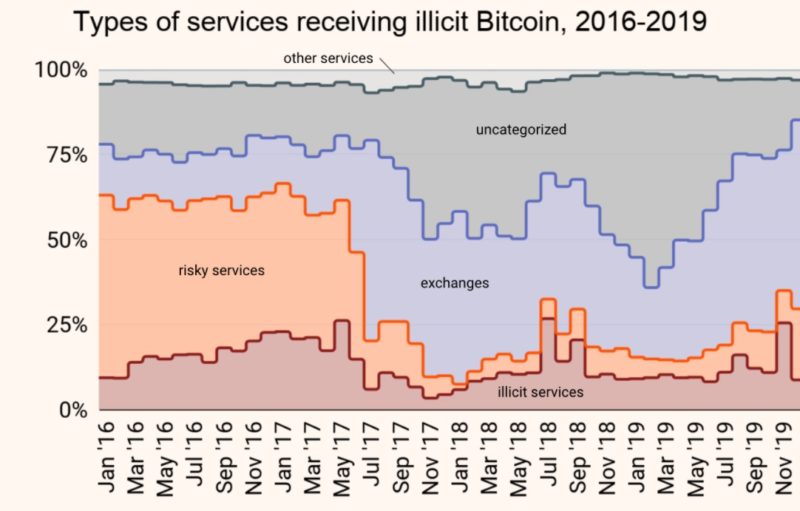Grin Market Opportunity
Grin is a privacy focused coin, which places it in the same sector as Monero, Zcash and the like. By protecting, sender, receiver, and transaction data information, the project aims to become digital cash in the true sense of the term. This is a $36.8T market.
Just like its privacy brethren, Grin has a chance to impact the $52T shadow economy as well as the traditional payments and remittance markets ($689B).
These are exciting numbers, but given the state of the blockchain industry as a whole, for now, they remain long-term targets.
In addition, Grin will have to compete for user attention with more established privacy and payment projects such as Monero, Zcash, and Bitcoin itself.
This will not be easy. Monero, for example, offers many of the same intrinsic qualities, privacy by default, decentralization, community funding, but has a much bigger community and a head start on merchant integration.
The more centrally governed projects, like Zcash or even the MimbleWimble alternate Beam, are able to drive development and adoption at a quicker pace in the short term.
Furthermore, as Bitcoin attains more and more privacy features, it becomes a looming threat to the entire privacy space. With its dominant network effects, it could make many of the smaller alts irrelevant.
In the absence of a strong catalyst, this leaves Grin at a major disadvantage. The mitigating factor is that most privacy projects don’t appear to be going after one another (Monero vs Zcash is a separate story) and look to be on friendly terms, if not outright cooperating.
The Beam team has even donated funds to support Grin development. The Grin team appears to be friendly with its counterparts from Monero, and the space as a whole looks to be collectively growing the pie instead of trying to divvy it up just yet.
Grin Underlying Technology
As a privacy coin Grin’s core USP is its anonymity and security. It offers private-by-default transactions that don’t overblow the size of the blockchain. Minimal information gets stored by the network, while the PoW algorithms help maintain the security and validity of operations. However, while the technology offers plenty of theoretical benefits, poor UX/UI and a lacking infrastructure are preventing the community from experiencing the full benefits of the project and limits its potential.
Privacy is enabled using the MimbleWimble protocol, which relies on Elliptic Curve Cryptography to structure transactions based on the verification of zero sums and possession of private keys. This approach verifies inputs and outputs of the transaction without revealing any amounts while also obfuscating the transaction trail. In addition, the project utilizes rangeproofs to prevent users from spending what they don’t have, and cut-through to reduce the amount of information required to be stored on the blockchain.
None of these instruments are unique to the project, what makes Grin special is its elegant combination of these tools in a way that balances privacy and scalability.
The concept is very promising, but is difficult to realize in a user-friendly way. For instance, in order to make transactions more lightweight, MimbleWimble does not utilize addresses. This forces senders and receivers to communicate off-chain in order to create a transaction. This could be done by sending a transaction file using a messaging service or via a running HTTP wallet listener.
This complicates the core use-case for the cryptocurrency and raises the entry barrier for an average end user.
Furthermore, it exposes a potential vulnerability of the network. In theory, a spy node could record all inputs and outputs before a block is mined. This would enable the perpetrator to build and analyze transaction graphs of the network and possibly discover sender IP, compromising privacy.
To mitigate this issue Grin uses Dandelion. It is a broadcasting delay mechanism by which transactions are first sent through a series of randomly selected peers and then diffused to the entire network. The bigger the peer pool the more difficult it is to link inputs to transactions. Given the currently small user base and a high entry barrier due to UX complexities, Grin’s privacy features could be suspect.
The UX/UI issues are not insurmountable and are currently being addressed. Wallet development and integration have been progressing, and solutions like Grinbox offer signs of improvement.
The project has an active GitHub. It launched the network in January of 2019 and has already pushed a major update, Grin v. 2.0.0, which includes improvements for the bulletproof rewind scheme, Node and Wallet APIs and more.
It also helps that Grin is currently ASIC resistant, due to its Cuckaroo29 PoW algorithm. It has been shown that ASIC resistant network offers more decentralization incentive and attract retail users. However, many acknowledge that in the long run ASIC dominance is inevitable.
Grin has chosen to gradually migrate over to an ASIC friendly Cuckatoo32 over the next two years. This will enable the network to enjoy the bootstrapping benefits of the ASIC resistant algorithm while the network is still fragile and then gravitate towards industrial scale mining once it is ready.
Still, this will put the onus on ecosystem development in the short term. In about a year the network will have 50% ASIC penetration and if the ecosystem does not rapidly mature by that time we could start to see a significant drop off in active addresses, similar to how it happened when ASICs were introduced to the Zcash network.
Ultimately, Grin technology is solid but its infrastructure is still raw. The core technology and its continued development show thought and care. However, without significant UX/UI improvements, the project will continue to lack appeal to all but the hardcore enthusiasts, which will impact core USPs and ecosystem growth as a whole. With the mainnet now live, Grin needs to evolve from an R&D project into a commercially viable network.
Grin Ecosystem Development
Grin’s nascent ecosystem is its greatest weakness, but also the biggest source of potential catalysts for growth. For the longest time, it has been buoyed by hype and unrealistic expectations.
Its community was made up of overly eager investors and speculators looking to catch the last lottery ticket of 2017-2018 alt boom. As the expectations have died down the ecosystem has been exposed for lacking both in quantity and quality of connections due to a basic lack of vital infrastructure and the alpha of operational processes.
Still, these issues are not unfixable and if components and tools continue to hit the market Grin will start to gain awareness for its utility. This should give the project a solid chance for growth and adoption.
Grin started as an R&D exercise back 2016, when an anonymous developer posted a file in the IRC channel #bitcoin-wizards describing MimbleWimble (reference to Harry Potter) as a private and scalable upgrade for Bitcoin. Several cryptography researchers took notice of the proposal and collaborated to launch Grin mid-2017. In many ways, the backstory shaped the development path of the project.
Striving to replicate Bitcoin’s path to adoption, Grin wanted to entice hardcore enthusiasts and long-view miners. However, the launch attracted many VC investors, and nearly $100M was invested into special-purpose investment vehicles to mine Grin. This made Grin’s genesis block one of the most expensive in history and ballooned expectations.
Unlike Bitcoin, Grin did not have years to quietly develop in the shadows, it quickly drew the attention of speculators. Lacking powerful influencers and whales Grin has not been able to match ecosystem growth with the hype.
There simply was not enough time to build up infrastructure and awareness and achieve meaningful on-chain activity.
(Review date: July 29th, 2019. This is a partial report. For early access and the full assessment, click here.)
The post appeared first on CryptoBriefing









